Chromium Titanium Sputtering Target
Introduction
The Chromium Titanium Sputtering Target is a specialized alloy material designed for thin film deposition in electronics, optics, and advanced surface engineering. By combining chromium’s hardness and corrosion resistance with titanium’s toughness and lightweight properties, this alloy enables the production of durable, functional coatings with excellent adhesion and stability. It is widely used in decorative films, wear-resistant coatings, and semiconductor applications.
Detailed Description
Chromium Titanium sputtering targets are fabricated using high-purity raw materials through vacuum melting or powder metallurgy processes. The resulting alloy exhibits a homogeneous microstructure that ensures consistent sputtering performance and stable thin film quality.
Key features include:
High Purity (≥99.9%) – ensures low contamination and reliable deposition results.
Strong Mechanical Integrity – prevents cracking during sputtering, extending target lifetime.
Excellent Corrosion & Wear Resistance – alloy films perform well in harsh environments.
Customizable Composition – common ratios include Cr:Ti = 50:50 at% or tailored blends for specific applications.
Optional Bonding – indium or elastomer bonding to copper backing plates for high-power magnetron sputtering systems.
Applications
Chromium Titanium sputtering targets are commonly used in:
Semiconductors – functional thin films in microelectronics.
Optical Coatings – reflective and protective coatings for lenses and optical devices.
Decorative Coatings – hard, corrosion-resistant coatings with metallic luster.
Wear-Resistant Films – protective layers in tools, automotive, and aerospace components.
Energy Devices – thin films for specialized battery and solar applications.
Technical Parameters
| Parameter | Typical Value / Range | Importance |
|---|---|---|
| Purity | 99.9% – 99.99% | Ensures consistent film quality |
| Composition | Cr:Ti (50:50 at% standard) | Provides balanced mechanical & corrosion properties |
| Diameter | 25 – 200 mm (customizable) | Fits different sputtering systems |
| Thickness | 3 – 10 mm | Influences sputtering rate |
| Bonding | Indium / Elastomer / Copper | Improves heat transfer and stability |
Comparison with Related Materials
| Material | Key Advantage | Typical Application |
|---|---|---|
| Chromium Titanium | Hard, corrosion-resistant, durable | Decorative & wear-resistant films |
| Pure Chromium | Excellent hardness & reflectivity | Protective & reflective coatings |
| Pure Titanium | Lightweight, strong adhesion | Decorative & functional coatings |
FAQ
| Question | Answer |
|---|---|
| Can the Cr/Ti ratio be customized? | Yes, we provide standard and custom atomic ratios. |
| Which industries use this target? | Electronics, optics, decorative coatings, aerospace, and energy. |
| Is bonding necessary? | Recommended for high-power sputtering to prevent cracking. |
| How are the targets packaged? | Vacuum-sealed, foam-protected, and shipped in export-safe cartons or crates. |
| What deposition methods are suitable? | Primarily magnetron sputtering, both DC and RF. |
Packaging
Chromium Titanium sputtering targets are carefully vacuum-sealed with moisture protection and individually labeled. Each unit is packed in foam-lined export cartons or wooden crates to ensure safe handling and transportation.
Conclusion
The Chromium Titanium Sputtering Target offers a reliable solution for producing hard, corrosion-resistant, and functional thin films. With high purity, customizable composition, and durable performance, it is a versatile choice for semiconductor, optical, decorative, and protective coating applications.
For detailed specifications and a quotation, please contact us at [sales@thinfilmmaterials.com].





Reviews
There are no reviews yet.